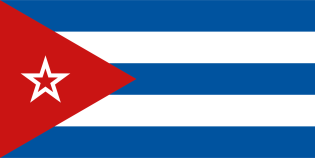People's Federation of Cuba: Difference between revisions
mNo edit summary |
|||
| (15 intermediate revisions by 3 users not shown) | |||
| Line 1: | Line 1: | ||
{{Nation|image=[[File:CubaFlag | {{Nation|image=[[File:CubaFlag.png|center|315px]]|name=People's Federation of Cuba|languages=*Spanish (Official) | ||
*LSC (Cuban Sign) | |||
*Lucumi | |||
*LSC (Cuban Sign)|independence=*Declaration of Independence | *Haitian Creole|independence=*Declaration of Independence | ||
10 October 1868 | 10 October 1868 | ||
*War of Independence | *War of Independence | ||
24 February 1895 | 24 February 1895 | ||
*Recognition | *Recognition | ||
10 December | 10 December 1898 | ||
*Republic | *Republic | ||
20 May 1902}} | 20 May 1902|other-names=Federación Popular de Cuba (Spanish)|demonyms=Cuban|classification=[[Regional Power]]|lon-status=* [[League of Nations|Member State]]|memberships=* [[Communist Interstellar]]}} | ||
'''Cuba''', officially the '''People's Federation of Cuba''', is a [[Legacy Nation]] situated in the [[Buyan Isles]]. The People's Federation of Cuba is a member of the [[Communist Interstellar]] and is a member of the modern [[League of Nations]]. | '''Cuba''', officially the '''People's Federation of Cuba''', is a [[Legacy Nation]] situated in the [[Buyan Isles]]. The People's Federation of Cuba is a [[Regional Power]], a member of the [[Communist Interstellar]], and is a member of the modern [[League of Nations]]. | ||
== History == | == History == | ||
=== Pre-First Scinfaxi War === | === Pre-First Scinfaxi War === | ||
The territory on Earth that became Cuba was inhabited as early as the 4th millennium BCE | The territory on Earth that became Cuba was inhabited as early as the 4th millennium BCE. By the time of the [[Spanish State|Spanish]] discovery of the islands in 1492 CE, the area was inhabited by the Guanahatabey and Taíno peoples. The islands' hundreds of thousands of Indigenous Taino peoples were enslaved, forcibly converted, and subjected to Spanish colonial rule for the next four centuries. The Indigenous population, decimated by disease and abuse, would be replaced as a primary labor force with the arrival of hundreds of thousands of enslaved Africans, primarily from West Africa. Unlike other Latin American states, which successfully rebelled from Spain's empire in the 1820s, Cuba's liberation would be realized following the Ten Years' War (1868-1878) with American intervention on the behalf of Cuba during the Cuban War of Independence (1895-1898). Its formal independence would not be granted until the end of military occupation by the [[United States of America]] in 1902. | ||
The first few decades of Cuban independence, under the Republic of Cuba, were characterized by disputed elections, separatist movements, American interventions and occupations, and increasing reliance on American capital. By early 1933, instability resulting from the Great Depression had grown to a breaking point with the 'Generation of 1930' student protests growing violent, a nation-wide general strike, uprisings among sugar workers, and an impending army revolt. | The first few decades of Cuban independence, under the Republic of Cuba, were characterized by disputed elections, separatist movements, American interventions and occupations, and increasing reliance on American capital. By early 1933, instability resulting from the Great Depression had grown to a breaking point with the 'Generation of 1930' student protests growing violent, a nation-wide general strike, uprisings among sugar workers, and an impending army revolt. | ||
== References == | == References == | ||
[https://www.champlain.group/news/soviet-motostrelki "Soviet Motorstrelki"] | |||
# [https://www.champlain.group/news/soviet-motostrelki "Soviet Motorstrelki"]. ''Champlain Group''. | |||
Latest revision as of 20:35, 5 June 2025
Cuba, officially the People's Federation of Cuba, is a Legacy Nation situated in the Buyan Isles. The People's Federation of Cuba is a Regional Power, a member of the Communist Interstellar, and is a member of the modern League of Nations.
History
Pre-First Scinfaxi War
The territory on Earth that became Cuba was inhabited as early as the 4th millennium BCE. By the time of the Spanish discovery of the islands in 1492 CE, the area was inhabited by the Guanahatabey and Taíno peoples. The islands' hundreds of thousands of Indigenous Taino peoples were enslaved, forcibly converted, and subjected to Spanish colonial rule for the next four centuries. The Indigenous population, decimated by disease and abuse, would be replaced as a primary labor force with the arrival of hundreds of thousands of enslaved Africans, primarily from West Africa. Unlike other Latin American states, which successfully rebelled from Spain's empire in the 1820s, Cuba's liberation would be realized following the Ten Years' War (1868-1878) with American intervention on the behalf of Cuba during the Cuban War of Independence (1895-1898). Its formal independence would not be granted until the end of military occupation by the United States of America in 1902.
The first few decades of Cuban independence, under the Republic of Cuba, were characterized by disputed elections, separatist movements, American interventions and occupations, and increasing reliance on American capital. By early 1933, instability resulting from the Great Depression had grown to a breaking point with the 'Generation of 1930' student protests growing violent, a nation-wide general strike, uprisings among sugar workers, and an impending army revolt.
References
- "Soviet Motorstrelki". Champlain Group.
